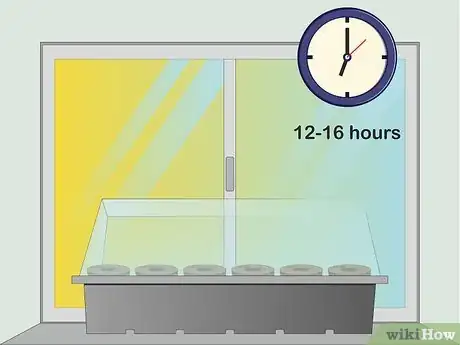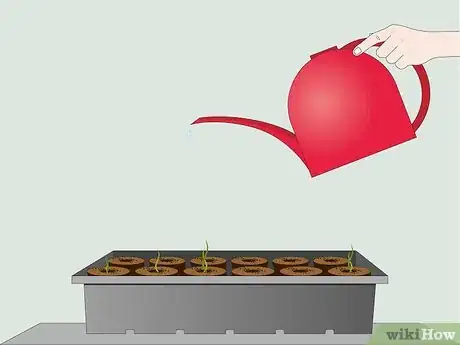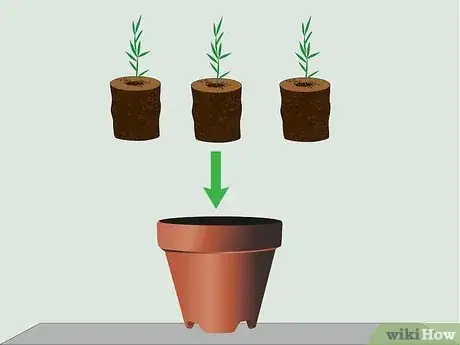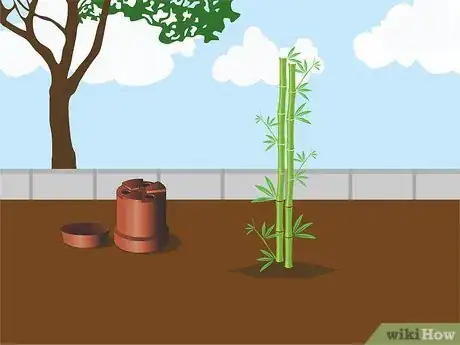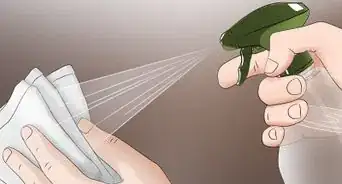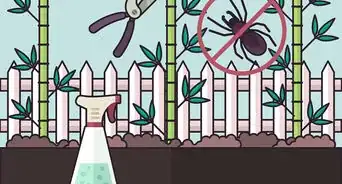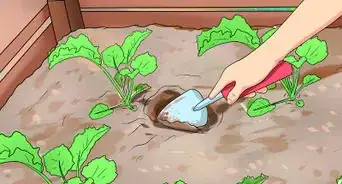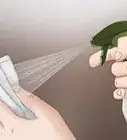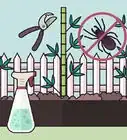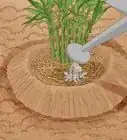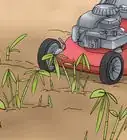This article was co-authored by Maggie Moran. Maggie Moran is a Professional Gardener in Pennsylvania.
wikiHow marks an article as reader-approved once it receives enough positive feedback. This article received 19 testimonials and 91% of readers who voted found it helpful, earning it our reader-approved status.
This article has been viewed 568,564 times.
Growing mature bamboo plants from seeds can be quite a challenge, but the final product is well worth the effort. To start off, order your seeds from a reputable supplier. Then, set up and soak your greenhouse pellets. After you've planted your seeds in the pellets, watch for them to grow quite quickly. In a month's time, transfer your bamboo seedlings to pots where they will reside until you decide to move them into a larger garden space.
Steps
Setting up Your Greenhouse
-
1Buy a miniature indoor greenhouse. You can purchase a greenhouse kit from gardening companies that will contain almost everything you'll need to plant bamboo seeds. The kit will have a holding tray, a number of peat pellets, labels, and a lid to create the greenhouse effect.
- This is a great way to grow bamboo seedlings all year round and in an indoor setting. The greenhouse that you purchase does not need to be specifically made for bamboo growing.
- Kits come in a variety of sizes from 6 plants up to over 70. A 50-plant greenhouse measures approximately 11 by 11 inches (28 by 28 cm). Your odds of success will improve if you choose a greenhouse with space for 50+ plants.
- After you buy your greenhouse, you'll notice that each pellet is already positioned in its own indention. This means that the greenhouse is ready for planting with almost no setup required.
-
2Submerge the pellets halfway under a layer of water. Get a pitcher and pour water into the holding tray until each pellet is halfway saturated. You'll need to adjust the amount of water that you use depending on how many pellets you need to cover. It's okay if the tops of the pellets get wet during the pouring process, as long as they are halfway covered.
- Check any diagrams and instructions on the greenhouse package before watering or planting. Some greenhouse kits even come with self-watering setups. You might need to fill a large basin with water. Then, the basin will feed into a watering mat under the pellets, reducing your watering intervals.
- Another option is to remove the pellets and place them into a rectangular metal cake pan. Then, pour boiling water over the pellets until it reaches the halfway point. The high temperature of the water is supposed to help sterilize the pellets.
- The ideal water temperature for watering your pellets is 10 to 15 °C (50 to 59 °F). You can also use distilled water for your seedlings to minimize any contaminants.
Advertisement -
3Let the pellets soak up the water for 5-10 minutes. Watch as the pellets begin to absorb the water almost immediately. Make sure that they are fully expanded within the containers and add a bit more water if any of the pellets seem to lag behind. Once the pellets are finished expanding, carry the tray over to a sink and drain away the remaining standing water.
- Your goal is to get the pellets to a state of dampness, but not sogginess, or they might lose their structure.
Planting the Seeds
-
1Purchase bamboo seeds from a reputable seller. Talk with your local gardening center about ordering bamboo seeds. Getting bamboo seeds can sometimes be a challenge because they must be quarantined for a period if they come from outside the United States. If you get a crop of seeds, make sure to plant them as soon as possible to increase their viability.[1]
- It's also a good idea to order more seeds than you actually intend to plant. This will increase your odds of growing mature plants, even if some seeds fail.
- Only buy seeds from a seller who can provide documentation showing that they follow all quarantine procedures established by the government.
-
2Soak your bamboo seeds in water for 1 full day. Fill up a shallow glass container up with water that is right around 85° F (30° C). Place your seeds into the water and let them sit undisturbed for between 12-24 hours. This kickstarts the germination process for your seeds and increases the odds of planting success.[2]
- Use a food thermometer to verify that the temperature doesn't get too hot or it could cook your seeds and ruin the possibility of planting.
- If you don't have a container handy, you can also place the seeds in a bag and fill it with water.
- Place the container in a warm spot to keep the temperature from dropping too quickly. It also helps to cover the container to keep the heat trapped longer.
-
3Plant a single seed in the center of each peat pellet. Use a wooden skewer to create a small hole in the top of each pellet. Then, place 1 seed in the center of the pellet. Use your finger to push the pellet down into the peat enough so that it is fully covered.[3]
Growing the Seedlings
-
1Position the greenhouse in a spot with 12-16 hours of indirect sunlight. This is the minimum amount of sunlight that the seeds will require to grow into seedlings. Avoid placing your greenhouse in direct sunlight or you'll risk burning the seeds. Keep your greenhouse covered with the lid in order to trap the warmth.
- A grow light can also provide warmth for your seedlings. Position an incandescent light at least 24 inches (61 cm) away from your plants to keep them from burning. A florescent light can be placed just 6 inches (15 cm) away from your greenhouse.
-
2Water the pellets each day until they are moist. If you see water accumulating on the surface of the pellet, stop and water a bit less next time. Be aware that each pellet may require varying amounts of water daily. You should see sprouts start to pop out of the soil after around 10 days post-planting.
-
3Remove the greenhouse lid when the sprouts start to touch it. If the tops of the sprouts reach the lid when closed, then you'll need to start leaving the lid off. The heat generated by the lid can actually burn the sprouts and damage them.
-
4Transplant the seedlings to larger planting containers after 30 days. Get a single 2 US gal (7.6 L) planting pot for every 3 pellets. Add potting soil into each pot until it is halfway full. Then, fill up the rest of the pots with bark mulch. Dig a hole for each pellet that is just slightly larger than the pellet's actual size. Gently lift each planting pellet and place it within a hole in the pot.
- It's fine to place multiple pellets in a single pot, as long as they are not directly touching.
- If a pellet doesn't have a visible sprout, you can still transplant it and hope that it will produce a plant in time.
- Cover each pellet with about 0.39 inches (0.99 cm) of potting soil, so that the top of the pellet is no longer visible.
-
5Place the pots in a location with at least 6 hours of indirect sunlight. Extended direct sun will continue to burn your bamboo seedlings, so make sure that your plants get about half sun, half shade. You might even need to move your pots around to ensure that they get at least 6 hours of light.
- The seedlings should stay a bright green color. If they turn yellow or brown, then they are getting too much sun.
Growing Mature Bamboo Plants
-
1Transplant the plants from pots to open soil in the fall or winter. Use a spade to dig a hole that is roughly twice the diameter and just as deep as the current pot. Then, mix that removed soil in with potting soil to create roughly a 50-50 mixture. Gently dig around the edges of the plant in the pot and turn it upside down until it loosens. Position this plant in the newly dug out hole in the soil.
- Look for a potting soil that is specifically made for plants in an open-soil garden. This type of soil will have a higher dirt density, as compared to standard potting soil.
-
2Water your new bamboo plants 2-3 times a week. Bamboo does best in soil that is moist, but well drained. If water is sitting on the surface of the dirt, then your bamboo may begin to rot.
- You can test the drainage of the soil beforehand by observing how it looks after a rain shower. If the water doesn't fully drain off and stays on the soil's surface, then it's probably not the best place to plant.
-
3Remove pests by hand or treat the plant with a pesticide. Some pests, such as aphids, are easily visible on bamboo. Simply pluck these tiny, green insects off the plant with your fingers and apply a pesticide to keep them from coming back. Other pests, such as mealybugs, are resistant to pesticides. In these situations, it's often best to simply spray the pests off the plants with a steady stream of water.[4]
-
4Keep the area around your plant's stem free of debris to prevent disease. Before you water your bamboo, use your hand to gently brush away any dead sticks or leaves on the top of the soil. These pieces of debris can spread dangerous fungi to your plant, which can cause root rot. Also, avoid over-watering your plants, as fungi grow best in saturated soil.[5]
- If your plant begins to bend at the stem and feels overly moist to the touch, then it may be suffering from rot. Dig up this plant in order to prevent the spread of the fungi.
Expert Q&A
Did you know you can get expert answers for this article?
Unlock expert answers by supporting wikiHow
-
QuestionHow long does it take to grow bamboo from seed?
 Maggie MoranMaggie Moran is a Professional Gardener in Pennsylvania.
Maggie MoranMaggie Moran is a Professional Gardener in Pennsylvania.
Home & Garden Specialist
-
QuestionHow long does it take to grow bamboo from seed?
 Maggie MoranMaggie Moran is a Professional Gardener in Pennsylvania.
Maggie MoranMaggie Moran is a Professional Gardener in Pennsylvania.
Home & Garden Specialist
-
QuestionHow does a bamboo plant reproduce?
 Maggie MoranMaggie Moran is a Professional Gardener in Pennsylvania.
Maggie MoranMaggie Moran is a Professional Gardener in Pennsylvania.
Home & Garden Specialist
Warnings
- When you buy seeds, make sure that you are getting them from a provider that is operating legally within your country. Otherwise, you risk importing seeds that have not been approved due to the possibility of disease.⧼thumbs_response⧽
Things You'll Need
- Bamboo seeds
- One rectangular pan
- A greenhouse container
- Water
- Potting soil
- Bark mulch
- Planting pots
References
- ↑ http://extension.uga.edu/publications/detail.html?number=B1357&title=Growing%20Bamboo%20in%20Georgia
- ↑ http://www.finegardening.com/article/jump-start-your-seeds
- ↑ https://getbusygardening.com/peat-pellets-vs-seed-cells/
- ↑ http://ipm.ucanr.edu/PMG/GARDEN/PLANTS/bamboo.html
- ↑ http://ipm.ucanr.edu/PMG/GARDEN/PLANTS/bamboo.html
About This Article
To grow bamboo from seed, start by soaking the seeds in bowl of water for 12 to 24 hours to help them germinate. Next, place peat pellets into a holding tray and add water so that each pellet is about halfway submerged. Once they have expanded, use your finger to push a seed into the center of each pellet. After planting, cover the tray with a greenhouse cover and place it in an area with indirect sunlight, like a window sill. Then, water the pellets daily to keep them moist, and transplant the seedlings into a larger planter after 30 days to give them room to grow. For advice from our Horticultural co-author on how to treat your bamboo for pests like aphids, read on!






